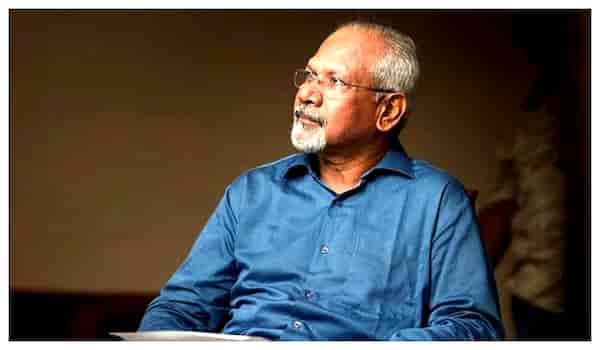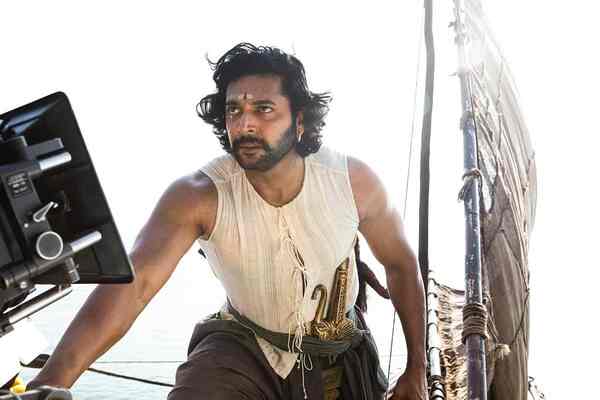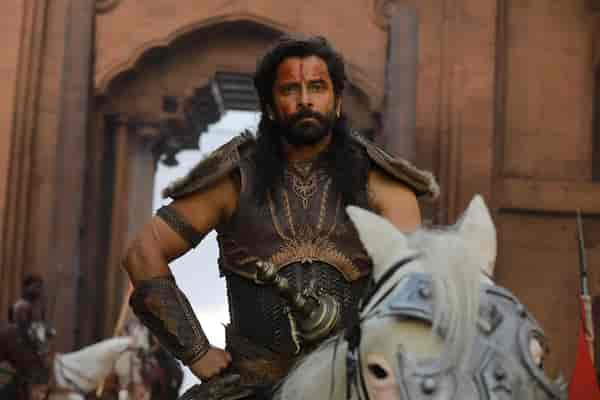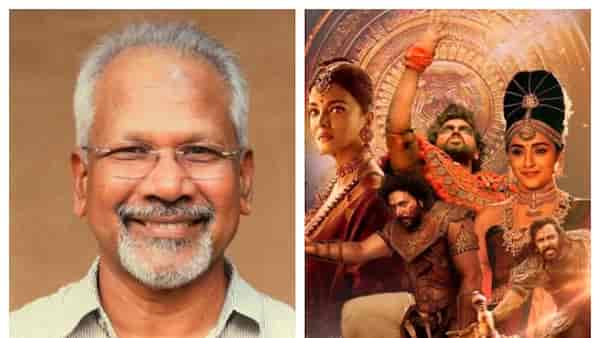My main goal is to be unpredictable: Ponniyin Selvan director Mani Ratnam
The first part of Mani Ratnam’s adaptation of Kalki Krishnamurthy’s popular novel had a theatrical release on September 30.

Last Updated: 12.56 AM, Oct 05, 2022
Mani Ratnam's childhood dream has come true with the release of his widely-anticipated Ponniyin Selvan, an adaptation of Kalki Krishnamurthy’s classic Tamil novel, which hit the screens on September 30.
Between 1950 and 1954, Ponniyin Selvan was serialised in Kalki magazine. In 1955, it was published in five volumes. The book was condensed by Mani Ratnam, Elango Kumaravel, and Jeyamohan into a movie that would be released in two parts.
When Lyca asked what the filmmaker was planning to do after Chekka Chivantha Vaanam, Mani Ratnam said, “Not planning anything, but I would like to do Ponniyin Selvan, and Subaskaran said yes; and that's how it started.”
Kamal Haasan, who played the lead in Nayakan (1987), wanted to do another film with Mani Ratnam, so the latter thought about Ponniyin Selvan, but the circumstances were not right at the time.
The Roja filmmaker read the novel when he was in high school and wanted to make it into a film ever since. “When I first read the book, all I could think of was a spectacle on a big screen. Making the characters from Kalki's universe speak has long been a goal of mine.”
Mani Ratnam has read Ponniyin Selvan numerous times. “Everything began when I bought the book from a library on Lloyds Road. The five portions can be thought of as five different movies. But given our budgetary constraints, we were only able to complete two,” he laughs.

He refrained from making the five volumes into a web series in the era of streaming. “When I was reading it, I could picture these characters taking up the entire screen. Ponniyin Selvan is always better viewed and appreciated in a theatre.”
The novel is set in the turbulent Chola kingdom of India in the 10th century when a civil war was on the horizon; due to serious rifts amongst the potential successors, to the reigning emperor, created by the power struggle between several branches of the royal family.
The Cholas became the most powerful and rich empire on the continent and one of the most prosperous and long-reigning in history, owing to the political and military unrest.
Despite being written and set in a thousand years ago, it nonetheless discusses topics that we still discuss today. “Ponniyin Selvan appears timeless, adaptable to different contexts and rings true. The book has always had a unique quality. The movie is entertaining as well, but the characters have a lot of depth,” assures Mani Ratnam.
Ponniyin Selvan demanded a lot more work from Mani Ratnam than he expected. “It explores a gamut of smaller human emotions such as desire, despair, and hatred.”
The adaptation was not the simplest task, adds the soft spoken Mani Ratnam. “We had to take the core of what Kalki (Krishnamurthy) had written and stick to it so that it could be completed as a single stream. The book is as accurate as we can make it because it is written realistically from the viewpoint of a common man. That perspective provided some context for us. You get the impression that Kalki is personally telling you the narrative from the way he writes.”
The phrase ‘Son of Ponni’, which is another name for the Cauvery river, is a reference to the historical Chola ruler Arulmozhi.
Arulmozhi is the army chief in Krishnamurthy's fictionalised historical narrative of the kingdom. Aditha Karikalan, his older brother, is the heir apparent, while Kundavai, their sister, is an astute administrator who cares deeply about maintaining the stability of the kingdom and protecting their ill father Sundara Chola.
The powerful Pazhuvettaraiyar clan, which holds control over the treasury, and a branch of the Pandyas, the former rulers of the country, are rivals of the Cholas.

Pazhuvur princess Nandini aspires to rule the realm. Vandhiyathevan, a warrior prince who becomes involved in the succession drama when Aditha Karikalan asks him to convey a message to the Chola ruler, is a pivotal character.
Azhwarkadiyan Nambi, a spy whose paths frequently intersect with Vandhiyathevan, while the warrior is travelling, is also causing trouble.
Mani Ratnam explains this in simple terms. “There are no superheroes in Ponniyin Selvan. There are no definite villains either. They’re all (real) people who have grey shades. It’s like an Alexandre Dumas. It’s an adventure, it is intriguing; it has fascinating characters.”

Ponniyin Selvan features a powerhouse cast including Aishwarya Rai Bachchan, Vikram, Sarath Kumar, Prabhu, Jayaram, Prakash Raj, Jayachitra, Jayam Ravi, Karthi, Trisha, Aishwarya Lekshmi, Sobhita Dhulipala, Rahman, Vikram Prabhu, Ashwin Kakumanu, Lal, Parthiban, Kishore and Riyaz Khan.
Many directors used Ponniyin Selvan characters in their contemporary movies over the years. For instance, Nandini (played by Aishwarya Rai in Mani Ratnam’s Ponniyin Selvan) served as the inspiration for Ramya Krishnan's Neelambari in Rajinikanth's Padayappa.
Mani Ratnam responded when asked if he has used any of the book's characters or plot points in any of his previous movies: “Well, Poonguzhali (Aishwarya Lekshmi plays the role in Ponniyin Selvan) serves as the inspiration for Shobana's character in the Thalapathi song, Sundari Kannaal.”
Mani Ratnam was ready to acknowledge that SS Rajamouli's Baahubali helped to establish the genre of historical and period dramas. “Despite being fiction, most of the characters in Ponniyin Selvan were real and we attempted to make the movie as authentic as we could. Writer Jeyamohan made the lines easier to grasp when incorporating ancient Tamil.”
A novel can commit an entire page to convey a character's sentiments, whereas a film can only do so through nonverbal clues and dialogues. Mani Ratnam had to explain certain things explicitly, others indirectly, and the rest, in a complex manner to provide audiences with a good viewing experience.
At least three of his earlier movies made direct use of the epic genre. Rajinikanth portrays a character in Thalapathi that is based on the Mahabharata epic's hero, Karna. Raavanan, which was simultaneously produced in Hindi as Raavan with a different lead actor, reimagines Sita's kidnapping as a noble protest against police excesses and sets important Ramayana scenes in a modern milieu. Also, the narrative of Aurangzeb was the inspiration for Chekka Chivantha Vaanam, which depicts brothers contending for the throne.
Discussing his writing process, Mani Ratnam observes, each film makes its boundaries. “All I have to do is make sure none of my earlier influences shows up in my current work. Even though Kalki's original material provided me with a lot of support, co-writing made my job simpler. Finding a common link for the screenplay was critical because it's difficult to overlook any chapter in the book. To make the story more compelling as a film, we made a few small changes to the original plot.”
Mani Ratnam claims that both of the parts of Ponniyin Selvan were filmed. “The second instalment will come out six to nine months later. For part 2, only the VFX and post-production work is still unfinished.”

Ponniyin Selvan has been adapted into movies on multiple occasions, all of which, have failed. In 1958, MG Ramachandran was the one to make the initial announcement that he would execute it with an ensemble cast. However, the project was unsuccessful. Mani Ratnam also believes that this is the ideal time for the film's release.
“Thirty years ago, we would have scouted locations without electricity lines and lamp posts. But things have gotten simpler because of VFX and the capacity to build large sets. Additionally, we did not have the mindset to watch movies in two parts back then. Baahubali started the craze, and audiences grew accustomed to watching sequels.”
Ponniyin Selvan-1 did not include Vairamuthu, a seven-time National Award-winner for songs. It was speculated that Mani Ratnam and AR Rahman may have avoided working with him, as a result of the vocalist Chinmayi Sripada's accusations of sexual harassment, besides other women.
When making Ponniyin Selvan, was Vairamuthu something Mani Ratnam missed? “Should I respond to this question? This seems to be going off in another direction!”
But, under the condition of anonymity, a technician, associated with Madras Talkies, revealed to us that Vairamuthu was, indeed, pulled from the project due to #MeToo accusations.
The conversation veered to the newest buzzword in the film circuit, pan-Indian, concerning PS-1. “Only the outside world gives such labels. I believe the more rooted a picture is, the more universal and true the cinema is. Satyajit Ray could make something set in a Bengali village, or Akira Kurosawa could make a film about Samurais that influenced someone like me. The picture has a better chance of gaining wider distribution the more honest it is. That's all I care about.”
Mani Ratnam doesn’t want people to guess what he’s going to do next. “I seek to deviate from what is considered the ‘Mani Ratnam style’. I try harder to rewrite patterns in my work when someone starts noticing them. My main goal is to be unpredictable.”
Mani Ratnam contends that he cannot make a bad movie and expect people to accept it just because he was filming during the pandemic. “It is my responsibility to give the results, and I think I have. Everything is learned from history. Ponniyin Selvan will still be relevant after 100 years.”
The filmmaker's main concern was the actors' physical state and well-being. “I would call each person and warn them against gaining weight. The pandemic was a crisis that required attention, just like unpredicted harsh weather. It must never be used as an excuse for a lousy film.”
At the audio launch of Ponniyin Selvan, Rajinikanth stated that he requested Mani Ratnam cast him as Periya Pazhuvettaraiyar, but the director had respectfully denied it.
“I don't want to offend Rajini's fans in any way. I'll have to alter the storyline if he comes on board. If I change the script for Rajini, Kalki's supporters will come after me,” Mani Ratnam says with a laughter.
He says casting is crucial, particularly for a movie like this one when the actor or actress must successfully pull off the period look and serve as the character's face and physicality.
“Everyone who read the novel has had these characters in their minds for such a long time. So, it is important to be able to give it a real face and body language. Therefore, casting did take some time,” acknowledges Mani Ratnam.
Aishwarya Rai was Mani Ratnam's first choice to play Nandini in Ponniyin Selvan when he intended to shoot the movie in 2011. “Again, in 2022, she was the only option. However, I was thinking about (Bollywood actor) Rekha in the late 1980s,” he confesses.
Aishwarya Rai previously had lead roles in Mani Ratnam’s Iruvar, Guru and Raavanan. “Choosing the best actor for the part is not the only criterion. He or she should be accessible and interested. You choose the best you can from it. Sometimes, all we need is one close-up to express a feeling or a notion. In this constrained space, the character must communicate. Only a cast this strong could have made this possible.”
Mani Ratnam describes Ponniyin Selvan's jewellery design as follows: “To make them credible, add authenticity to the period, and maintain the feeling of royalty, we placed significant emphasis on the costumes. We were extremely fortunate to work with real gold jewellery and to have Kishandas (the jewellery designer) on board. The artisans worked around the small details of the Chola period and made the ornaments specific to the characters.”
Ponniyin Selvan-1 is bankrolled by Madras Talkies and Lyca Productions and Siva Ananth serves as executive producer. Tamil, Hindi, Telugu, Malayalam, and Kannada versions of the movie were released in India in both standard and IMAX formats.

The film’s elaborate set pieces, which look fluid and effortless on screen, were by dint of detailed planning from Mani Ratnam and his team, which includes top talents such as art director Thota Tharrani, cinematographer Ravi Varman, editor Sreekar Prasad, and so on.
PS-1 is one of the movies that the Indian film industry hopes would attract moviegoers after the pandemic. “The past two and a half years had been terrible. We need a little more time to cool off and go back to being ourselves. But I think people are ready to return to big screens when something significant and fascinating happens,” notes Mani Ratnam.

Even in his late 60s, what motivates him? “I come up with new ways to tell stories every day. If we look closely enough, everything does have the ability to have an impact on us. One cannot afford to miss the fact that, to those who are creative, everything around them is a story!”

 Premium
Premium